Compassionate rosters and rotas are becoming crucial. The health and social care system is awaiting the ‘perfect storm of pressures’ according to research conducted by the Royal College of Nursing. Meanwhile, a survey conducted by the NHS Confederation, has found that NHS leaders are describing the current service as already being at “tipping point”.
Staff vacancy rates, burnout, patient waiting times and hospital bed occupancies are collectively putting an unprecedented degree of pressure on the health service. That’s prior to any winter peak trends typically seen around this time of year. With such a magnitude of challenges to face, it’s time to raise the question – what can be done to help alleviate the psychological and physical impact to staff from the incoming ‘perfect storm pressures’, so they have a more positive work experience and deliver the safest patient care?
Building compassion into rosters and rotas
“It’s impossible to book leave months or even years in advance. Or if I do, it gets cancelled nearer the time.”
“Too little notice when I’m working.”
“No ability to make requests or self-roster. Swaps are only means of control.”
These are just some of the comments that we hear from junior doctors as an organisation, but they are also echoed in frustration across social media channels on a recurring basis.
And whilst there is no magic solution to any of these challenges, there are relatively simple steps that can be taken to achieve more compassionate rotas and rosters.
Practical steps to support compassionate rotas and rosters
1. Ask if there is a dedicated roster policy for your staff group
At the BMJ Leaders in Healthcare conference, 8-11 November 2021, we asked an audience, primarily made up of junior doctors, whether they’d seen a dedicated roster policy for doctors. Very few confirmed that they had.
“I’ve personally never seen one in my 12 years as a junior doctor. Yet, by having one, it would make the process so much more transparent and would help to prevent staff feeling as though they’re just ‘number 6’ on the rota.” Dr Michelle Horridge, Registrar in Public Health
There will be instances where you find that a dedicated policy is already written, yet it may not be easy to access. This is often the case for temporary members of staff who work across different organisations. As they’re not a substantive member of staff, there’s a high chance that they won’t have access to the organisation’s intranet – often a local storage source for company and workforce policies.
In the ideal circumstance of finding a dedicated policy, read it, and explore how wellbeing and welfare are built-in. If there’s none in place and you feel as though you want to contribute and make a change, offer to support a revision or new document that will ensure staff are rightfully informed to make decisions.
“It’s difficult to represent a ‘one-size-fits-all’ approach to rota and roster policies, as there are differences across staffing groups and in particular, junior doctor contracts. However, if a dedicated policy is already in place, make sure that it is visible and accessible for all staff, whatever their role and whenever they’re working.” Dr Michelle Horridge, Registrar in Public Health
2. Explore data sets and encourage collaborative working
There’s more information available to you besides the policies, but often the challenge is knowing where to look or who to ask.
Data sets from rostering processes can help to encourage collaborative conversations. ‘How often are last-minute changes happening in my area?’, ‘how much annual leave is accepted vs denied?’ and ‘how much training leave is being approved?’ are always good questions to ask.
“It’s challenging on both sides of the equation. Clinicians are not getting the best experience when receiving and working rotas and rosters – last-minute requests, changes to shifts, and cancelled leave. It’s also very difficult for rota and roster coordinators, who have to ensure working patterns are safe and compliant. The opportunity lies within a conversation, whether that’s a one-off, or two hours every six months. Dr Michelle Horridge, Registrar in Public Health
It is also key to remember that this shouldn’t just be the responsibility of the clinician and rota/roster coordinator. Senior managers within a healthcare organisation will understand that it’s difficult to fill gaps and therefore they should be looking at why people don’t want to cover certain shifts. It may be a simple and easy-to-fix issue or a complex, deep-rooted problem, but taking the time to understand where it originates will bring you one step closer to finding a solution.
3. Educate those that are building the rotas and rosters
No one is perfect. We all benefit from regular feedback and training to support our roles and responsibilities.
Whilst it’s unusual at the end of a shift to be asked ‘how was the rota’, every now and again it’s a good way to understand first-hand what good and bad looks like, walking in the shoes of a clinician to understand compassionate rosters and rotas.
If you don’t receive these questions as a clinician, make a move and open the line of communication between you and the rota/roster coordinator.
As a final point, whether you’re a junior doctor or roster coordinator, it’s key to remember that there is a person on both sides: someone who is just trying to do their job. However, there also needs to be a level of comprising. In a junior doctor’s case, it’s not just about completing a shift. Junior doctors also need to find the time to fit in training, whilst striving to achieve the right work/life balance for the sake of their own wellbeing and the welfare of loved ones.
Show us what good looks like
We’d like to see some examples of dedicated policies and positive collaborations between clinicians and rota/roster teams.
Your examples could help to support other people and organisations who may already be searching for the answers to compassionate rosters and rotas.
To share some examples or make a request to be put in contact with an organisation that has great examples in action, get in contact. Simply complete the form below and we’ll be in touch.
It’s time to rewrite the narrative on workforce policy. Let’s bring policies to life!
Get in touch to find out more
Thank you
Thank you for requesting more information. One of our colleagues will be in touch very shortly.
Please send your examples to [email protected].





